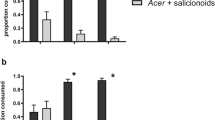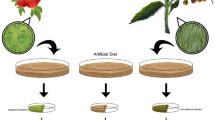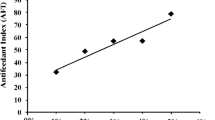Abstract
Natural populations of Datura wrightii in southern California consist of two distinctly different phenotypes. The leaves of one phenotype are densely covered with nonglandular trichomes and feel velvety. The other phenotype is covered with larger type IV glandular trichomes that excrete a sticky exudate. Neonate larvae of M. sexta reared on velvety leaves developed significantly faster than larvae on sticky leaves. Larvae on sticky leaves took 28% longer to reach the prepupal stage. Survival and pupal weight were not significantly different between the two groups. First instars of M. sexta had a significantly higher consumption rate on velvety leaves than on sticky leaves. Removal of the exudate from stickly leaves significantly increased larval consumption rates compared to unwashed controls. Female moths did not show an oviposition preference; both in the lab and in the field the two trichome phenotypes of D. wrightii received similar egg loads. Because there were no significant differences in other nutritional factors between the two plant phenotypes, we concluded that the exudate was responsible for the effect. We isolated a complex mixture of sugar esters (SE) as the biologically active compounds in the exudate of D. wrightii. The SE mixture was composed of glucose esterified with several combinations of straight chain C6–C9 acids. By comparing GC-MS spectra of synthetic SE with the SE extracted from D. wrightii, we identified one of the SE as 3′-O-hexanoyl glucose.
Similar content being viewed by others
REFERENCES
Allen, S. E. 1974. Chemical Analysis of Ecological Material. John Wiley & Sons, New York.
Appel, H. M., and Martin, M. M. 1992. Significance of metabolic load in the evolution of host specificity of Manduca sexta. Ecology 73:216–228.
Avery, A., Satina, S., and Rietsema, J. 1959. Blakeslee: The Genus Datura. Ronald Press, New York.
Berdegue, M., Trumble, J. T., Hare, J. D., and Redak, R. A. 1996. Is it enemy–free space? The evidence for terrestrial insect and freshwater arthropods. Ecol. Entomol. 21:203–217.
Buta, J. G., Lusby, W. R., Neal, J. W., Waters, R. M., and Pittarelli, G. W. 1993. Sucrose esters from Nicotiana gossei active against the greenhouse whitefly Trialeuroides vaporariorum. Phytochemistry 32:859–864.
Casey, T. 1976. Activity patterns, body temperature and thermal ecology in two desert caterpillars (Lepidoptera: Sphingidae). Ecology 57:485–497.
Cheeke, P. R., and Shull, L. R. 1985. Natural Toxicants in Feeds and Poisonous Plants. AVI Publishing, Westport, Connecticut.
Chortyk, O. T., Pomonis, J. G., and Johnson, A. W. 1996. Syntheses and characterizations of insecticidal sucrose esters. J. Agric. Food Chem. 44:1551–1557.
Dimock, M. B., and Kennedy, G. G. 1983. The role of glandular trichomes in the resistance of Lycopersicon hirsutum f. glabratum to Heliothis zea. Entomol. Exp. Appl. 33:263–268.
Duffey, S. S. 1986. Plant glandular trichomes: their partial role in defence against insects, pp. 152–171, in B. E. Juniper and T. R. E. Southwood (eds.). Insects and the Plant Surface. Edward Arnold, London.
Duffey, S. S., and Isman, M. B. 1981. Inhibition of insect larval growth by phenolics in glandular trichomes of tomato leaves. Experientia 37:574–576.
Fliniaux, M. A., Manceau, F., and Jacquin Dubreuil, A. 1993. Simultaneous analysis of l–hyoscyamine, l–scopolamine and dl–tropic acid in plant material by reversed–phase high–performance liquid chromatography. J. Chromatogr. 644:193–197.
Gilmore, J. U. 1938. Observations on the hornworms attacking tobacco in Tennessee and Kentucky. J. Econ. Entomol. 31:706–707.
Goffreda, J. C., Mutschler, M. A., AvÉ, D. A., Tingey, W. M., and Steffens, J. C. 1989. Aphid deterrence by glucose esters in glandular trichome exudate of the wild tomato, Lycopersicon pennellii. J. Chem. Ecol. 15:2135–2147.
Goffreda, J. C., Steffens, J. C., and Mutschler, M. A. 1990. Association of epicuticular sugars with aphid resistance in hybrids with wild tomato. J. Am. Soc. Hortic. Sci. 115:161–165.
Harborne, J. B. 1973. Phytochemical Methods, 1st ed. Chapman and Hall, London.
Hodges, R. W. 1971. The Moths of North America and Mexico, including Greenland. Fascicle 21. Sphingoidea (Hawkmoths). E. W. Classey Ltd. and R. B. D. Publications Inc., London.
Hoffman, J. D., Lawson, F. R., and Yamamoto, R. 1966. Tobacco hornworms, pp. 479–486, in C. N. Smith (ed.). Insect Colonization and Mass Production. Academic Press, New York.
Juvik, J. A., Shapiro, J. A., Young, T. E., and Mutschler, M. A. 1994. Acylglucoses from wild tomatoes alter behavior and reduce growth and survival of Helicoverpa zea and Spodoptera exigua (Lepidoptera: Noctuidae). J. Econ. Entomol. 87:482–492.
Kennedy, G. G., and Yamamoto, R. T. 1979. A toxic factor causing resistance in a wild tomato to the tobacco hornworm and some other insects. Entomol. Exp. Appl. 26:121–126.
Kennedy, G. G., Yamamoto, R. T., Dimock, M. B., Williams, W. G., and Bordner, J. 1981. Effect of daylength and light intensity on 2–tridecanone levels and resistance in Lycopersicon hirsutum f. glabratum to Manduca sexta. J. Chem. Ecol. 7:707–716.
King, R. R., and Calhoun, L. A. 1988, 2,3–Di–O–and 1,2,3–tri–O–acylated glucose esters from the glandular trichomes of Datura metel. Phytochemistry 27:3761–3764.
King, R. R., Calhoun, L. A., and Singh, R. P. 1988. 3,4–Di–O–and 2,3,4–tri–O–acylated glucose esters from the glandular trichomes of nontuberous Solanum Species. Phytochemistry 27:3765–3768.
Lauter, D. J., and Munns, D. N. 1986. Water loss via the glandular trichomes of chickpea (Cicer arietinum L.). J. Exp. Bot. 37:640–649.
Liedl, B. E., Lawson, D. M., White, K. K., Shapiro, J. A., Cohen, D. E., Carson, W. G., Trumble, J. T., and Mutschler, M. A. 1995. Acylsugars of wild tomato Lycopersicon pennellii alters settling and reduces oviposition of Bemisia argentifolii. J. Econ. Entomol. 88:742–748.
Liu, T. X., Stansly, P. A., and Chortyk, O. T. 1996. Insecticidal activity of natural and synthetic sugar esters against Bemisia argentifolii (Homoptera: Aleyrodidae). J. Econ. Entomol. 89:1233–1239.
Luckwill, L. C. 1943. The genus Lycopersicon, An Historical, Biological, and Taxonomic Survey of the Wild and Cultivated Tomatoes. The University Press, Aberdeen.
Madden, A. H., and Chamberlin, F. S. 1945. Biology of the tobacco hornworm in the southern cigar–tobacco district. USDA Technical Bulletin 896, pp. 1–51.
McFadden, M. W. 1968. Observations on feeding and movement of tobacco hornworm larvae. J. Econ. Entomol. 61:352–356.
Munz, P. A. 1973. A Californian Flora (with Supplement), 1973 ed. University of California Press, Berkeley.
Neal, J. J., Steffens, J. C., and Tingey, W. T. 1989. Glandular trichomes of Solanum berthaultii and resistance to the Colorado potato beetle. Entomol. Exp. Appl. 51:133–140.
Neal, J. J., Tingey, W. T., and Steffens, J. 1990. Sucrose esters of carboxylic acids in glandular trichomes of Solanum berthaultii deter settling and probing by green peach aphid. J. Chem. Ecol. 16:487–497.
Oatman, E. R., and Platner, G. R. 1978. Effect of mass releases of Trichogamma pretosium against Lepidopterous pests on processing tomatoes in southern California, with notes on host egg population trends. J. Econ. Entomol. 71:896–900.
Oatman, E. R., Platner, G. R., Wyman, J. A., Van Steenwyk, R. A., Johnson, M. W., and Browning, H. W. 1983. Parasitization of lepidopterous pests on fresh market tomatoes on southern California. J. Econ. Entomol. 76:452–455.
Patouraux–PromÉ, D., and PromÉ, J. C. 1984. Carbohydrates, pp. 105–156, in G. Odham, L. Larsson, and P. A. Maerdh (eds.). Gas Chromatography–Mass Spectrometry Applications in Microbiology. Plenum Press, New York.
Rabb, R. L., and Bradley, J. R. 1968. The influence of host plants on parasitism of eggs of the tobacco hornworm. J. Econ. Entomol. 61:1249–1252.
Severson, R. F., Chortyk, O. T., Stephenson, M. G., Akey, D. H., Neal Jr., J. W., Pittarelli, G. W., Jackson, D. M., and Sisson, V. A. 1994. Characterization of natural pesticide from Nicotiana gossei, pp. 107–121, in P. A. Hedin (ed.). Bioregulators for Crop Protection and Pest Control. ACS Symposium Series 557. American Chemical Society, Washington, D.C.
Simms, E. L. 1992. Costs of plant resistance to herbivory, pp. 392–425, in R. S. Fritz and E. L. Simms (eds.). Plant Resistance to Herbivores and Pathogens. Ecology, Evolution, and Genetics. The University of Chicago Press, Chicago.
Steffens, J. C., Kowalski, S. P., and Yu, H. 1990. Characterization of glandular trichome and plastid polyphenol oxidases of potato, pp. 103–112, in M. E. Vayda and W. D. Park (eds.). The Molecular and Cellular Biology of Potato. CAB International, Oxford.
Sweeney, R. A. 1989. Generic combustion method for determination of crude protein in feeds: A collaborative study. J. Assoc. Off Anal. Chem. 72:770–774.
Thompson, J. N. 1988. Evolutionary ecology of the relationship between oviposition preference and performance of offspring in phytophagous insects. Entomol. Exp. Appl. 47:3–14.
Thurston, R. 1970. Toxicity of trichome exudates of Nicotiana and Petunia species to tobacco hornworm larvae. J. Econ. Entomol. 63:272–274.
Tingey, W. M. 1981. The environmental control of insects using plant resistance, pp. 175–197, in D. Pimentel (ed.). CRC Handbook of Pest Management in Agriculture, Vol. 1. CRC Press, Boca Raton, Florida.
Van Dam, N. M., and Harf, J. D. 1998. Differences in distribution and performance of two sapsucking herbivores on glandular and non–glandular trichomes in Datura wrightii. Ecol. Entomol. 23:22–32.
van Dam, N. M., Hare, J. D., and Elle, E. E. 1998. Inheritance and distribution of trichome phenotypes in Datura wrightii. J. Heredity. In press.
Walters, D. S., and Steffens, J. C. 1990. Branched chain amino acid metabolism in the biosynthesis of Lycopersicon pennellii glucose esters. Plant Physiol. Biochem. 93:1544–1551.
Williams, W. G., Kennedy, G. G., Yamamoto, R. T., Thacker, J. D., and Bordner, J. 1980. 2–Tridecanone: A naturally occurring insecticide from the wild tomato Lycopersicon hirsutum f. glabratum. Science 202:888–889.
Yamamoto, R. T., Jenkins, R. Y., and McClusky, R. K. 1969. Factors determining the selection of plants for oviposition by the tobacco hornworm Manduca sexta. Entomol. Exp. Appl. 12:504–508.
Yencho, G. C., Renwick, J. A. A., Steffens, J. C., and Tingey, W. M. 1994. Leaf surface extracts of Solanum berthaultii Hawkes deter Colorado potato beetle feeding. J. Chem. Ecol. 20:991–995.
Author information
Authors and Affiliations
Rights and permissions
About this article
Cite this article
Van Dam, N.M., Hare, J.D. Biological Activity of Datura wrightii Glandular Trichome Exudate Against Manduca Sexta Larvae. J Chem Ecol 24, 1529–1549 (1998). https://doi.org/10.1023/A:1020963817685
Issue Date:
DOI: https://doi.org/10.1023/A:1020963817685




